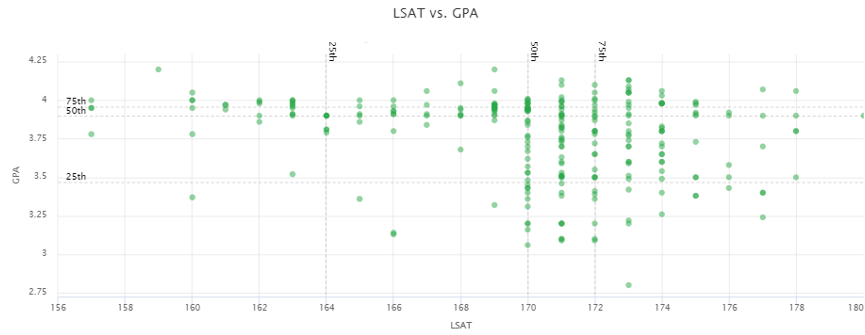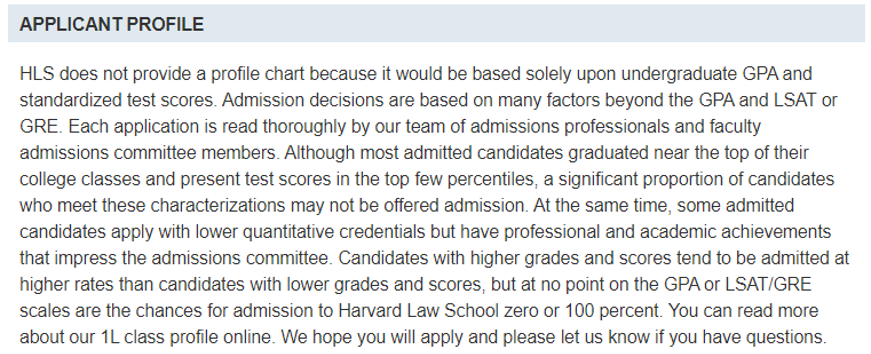Thank you!
The full article is available below.
You will also receive a follow-up email containing a link so you can come back to it later.

As we gear up for the 2021-2022 law school admissions cycle, there has been a new wave of posts asking, “what are my admission chances?” A number of websites and methods exist to bring aspiring applications tiny margins of hope. However, like all things on the internet, these websites need to be taken with a grain of salt.
Two Student-Based Admission Chances Sites
There are two main websites that provide admission chances based in search form: MyLSN and LawSchoolData. These sites are based on self-reported data such as GPA, LSAT, URM status, month applied, etc.
MyLSN pulls data from LawSchoolNumbers, which is slightly outdated and not updated as often as LawSchoolData. LawSchoolData pulled in information from LawSchoolNumbers in the past, which means that applicants who used both websites may be showing up in the data more than once.
Self-Reported Data
Both sites used self-reported data, which has several issues. The first is that people on the internet lie. Shocking, I know! We don’t know whether or not we can trust the data provided.
The second is that the internet tends to draw in people who are disproportionately involved in the law school process: the high achievers. For instance, the acceptance rates reported on LSD and LSN school profiles for the Top 40 schools tend to be about 10% higher, on average, than the acceptance rates reported on school’s ABA reports.
The applicants on LSData also have disproportionately high LSATs compared to the overall applicant pool:

A third issue is that LSData and LSN users are not representative of the overall applicant pool. The number of applicants on LSData per a particular school have not broken 30% of the overall applicants a school actually receives. That means that at least 70% of a particular school’s applicants are not reflected on these online websites! Your “stats twin” could be in that 70%.
A fourth issue is that people don’t update their profiles. In a given year for a given school, up to 20% of applicants don’t post a final result. This can be especially bad for examining waitlist data and waitlist movement. Sometimes people get in and then just don’t get around to updating their profiles. Their successes, and failures, don’t end up showing up in the search results.
LSAC's Predictor: Regression Modeling
LSAC has a “search” function that uses regression modeling based off of prior year applicant data to provide a very wide range of chances. While this has the benefit of utilizing all of the data LSAC has available on actual applicants, it comes with a number of flaws. The first is that not all schools opt into the search function. That includes T6 schools such as Harvard, Yale, Stanford, Chicago, and NYU.
The second is that regression modeling is inherently flawed, especially for outlier cases such as “splitters” (one stat over median and one stat under) and “URMs” (under-represented minorities). Regression analysis is used in statistics to see the relationship between a dependent variable (admissions) and one or more independent variables (GPA, LSAT). Linear regression is, well, linear: it attempts to show a straight line between the variables.
This doesn’t accurately reflect “splitter” friendly schools, who are willing to take anyone who is over at least one median (shown on LSData as the “right angle of death”):

Those results are not exactly linear, and don’t make for great regressions.
Law Schools: Admissions Formulas
Some schools are kind enough to publish their admissions formulas for us on the LSAC website, known as the “Admissions Index.” These can be found on your transcript page under “Related Information” -> “Admissions Index.” Not every school publishes these formulas.
These formulas are based on similar concepts, where (A*LSAT) + (B*GPA) + Constant = some number. Most schools use the cumulative uGPA as calculated by LSAC; some use an “adj” number or the degree GPA. Schools generally use these formulas to sort applicants into “presumptive admit” and “presumptive deny” categories. Candidates are rejected from the presumptive admit pile every year. Candidates are accepted from the presumptive deny pile every year. We unfortunately are not given the applicable cut-offs or formula targets for each school along with the Index, which render these basically useless for predicting outcomes. It is a good way to see which schools care more about LSAT and which ones care more about GPA, however.
The Index for the 2019-2020 cycle can be found in the chart here.
Law Schools: Applicant Profile Grid
The final, most accurate, and unfortunately rarest option to check how your individual stats fare is the Applicant Profile Grid that some schools publish in their Law School Descriptions on the LSAC website. The Applicant Profile Grid looks roughly as follows:

While the Applicant Profile Grids are ranged, it can still provide an understanding of who all applied to a given school and how their particular stats fared. It does not provide detail such as did an applicant apply Early Decision, were they URM, etc.
Most schools post some kind of caveat in the Applicant Profile section instead:

And while such caveats don’t give us the sweet, sweet comfort of having a 70% chance somewhere, they do make a valid point: an LSAT score or GPA can open a door for us; the rest of our application is necessary to get us through it. We can spend the time obsessing over what an arbitrary website says our chances might be, even with all of these websites’ flaws, or we can study for the LSAT. Or on our essays. We can make the most compelling application possible.
And that effort can’t be captured on any regression model.
Unlock the Full Article
Bring Your Goals Within ReachTell us a little about yourself and your goals to display the full article and gain access to more resources relevant to your needs.
Interested in reading more? Fill out the form to read the full article.